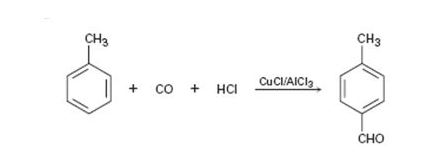
EBK ORGANIC CHEMISTRY
9th Edition
ISBN: 9780100591318
Author: McMurry
Publisher: YUZU
expand_more
expand_more
format_list_bulleted
Concept explainers
Textbook Question
Chapter 16.SE, Problem 41MP
In the Gatterman-Kochreaction, a formyl group (—CHO) is introduced directly onto a benzene ring. For example, reaction of toluene with CO and HCl in the presence of mixed CuCl/AlC3 gives p-methylbenzaldehyde. Propose a mechanism.

Expert Solution & Answer
Trending nowThis is a popular solution!

Students have asked these similar questions
When talking about the acidity of carboxylic acids, is it the same thing to say higher or stronger acidity?
Using the following two half-reactions, determine the pH range in which $NO_2^-\ (aq)$ cannot be found as the predominant chemical species in water.* $NO_3^-(aq)+10H^+(aq)+8e^-\rightarrow NH_4^+(aq)+3H_2O(l),\ pE^{\circ}=14.88$* $NO_2^-(aq)+8H^+(aq)+6e^-\rightarrow NH_4^+(aq)+2H_2O(l),\ pE^{\circ}=15.08$
Indicate characteristics of oxodec acid.
Chapter 16 Solutions
EBK ORGANIC CHEMISTRY
Ch. 16.1 - Prob. 1PCh. 16.2 - Propose a mechanism for the electrophilic...Ch. 16.2 - How many products might be formed on chlorination...Ch. 16.2 - When benzene is treated with D2SŪ4. deuterium...Ch. 16.3 - Prob. 5PCh. 16.3 - What is the major monosubstitution product from...Ch. 16.3 - Identify the carboxylic acid chloride that might...Ch. 16.4 - Rank the compounds in each of the following groups...Ch. 16.4 - Predict the major products of the following...Ch. 16.4 - Prob. 10P
Ch. 16.4 - Prob. 11PCh. 16.4 - Acetanilide is less reactive than aniline toward...Ch. 16.4 - Prob. 13PCh. 16.5 - At what position would you expect electrophilic...Ch. 16.5 - Show the major product(s) from reaction of the...Ch. 16.6 - The herbicide oxyfluorfen can be prepared by...Ch. 16.7 - Treatment of p-bromotoluene with NaOH at 300°C...Ch. 16.8 - Prob. 18PCh. 16.8 - Prob. 19PCh. 16.8 - Prob. 20PCh. 16.9 - Prob. 21PCh. 16.10 - Prob. 22PCh. 16.10 - Prob. 23PCh. 16.SE - Prob. 24VCCh. 16.SE - The following molecular model of a...Ch. 16.SE - Prob. 26VCCh. 16.SE - Prob. 27VCCh. 16.SE - Aromatic iodination can be carried out with a...Ch. 16.SE - Prob. 29MPCh. 16.SE - The carbocation electrophile in a Friede1-Crafts...Ch. 16.SE - Prob. 31MPCh. 16.SE - The nitroso group, —N=O, is one of the few...Ch. 16.SE - Triphenylmethane can be prepared by reaction of...Ch. 16.SE - Using resonance structures of the intermediates,...Ch. 16.SE - Benzene and alkyl -substituted benzenes can be...Ch. 16.SE - Prob. 36MPCh. 16.SE - Hexachlorophene, a substance used in the...Ch. 16.SE - Benzenediazonium carboxylate decomposes when...Ch. 16.SE - 4-Chloropyridine undergoes reaction with...Ch. 16.SE - Propose a mechanism to account for the following...Ch. 16.SE - In the Gatterman-Kochreaction, a formyl group...Ch. 16.SE - Treatment of p-tert-butylphenol with a strong acid...Ch. 16.SE - Benzyl bromide is converted into benzaldehyde by...Ch. 16.SE - Prob. 44MPCh. 16.SE - Prob. 45MPCh. 16.SE - Prob. 46APCh. 16.SE - Prob. 47APCh. 16.SE - Prob. 48APCh. 16.SE - Predict the major monoalkylation products you...Ch. 16.SE - Name and draw the major product(s) of...Ch. 16.SE - Prob. 51APCh. 16.SE - Prob. 52APCh. 16.SE - What product(s) would you expect to obtain from...Ch. 16.SE - Prob. 54APCh. 16.SE - How would you synthesize the following substances...Ch. 16.SE - Prob. 56APCh. 16.SE - Prob. 57APCh. 16.SE - Prob. 58APCh. 16.SE - Prob. 59APCh. 16.SE - Prob. 60APCh. 16.SE - Prob. 61APCh. 16.SE - Prob. 62APCh. 16.SE - Prob. 63APCh. 16.SE - How would you synthesize the following substances...Ch. 16.SE - Prob. 65APCh. 16.SE - Prob. 66APCh. 16.SE - Draw resonance structures of the intermediate...Ch. 16.SE - Prob. 68APCh. 16.SE - p-Bromotoluene reacts with potassium amide to give...Ch. 16.SE - Prob. 70APCh. 16.SE - Prob. 71APCh. 16.SE - Prob. 72APCh. 16.SE - Use your knowledge of directing effects, along...Ch. 16.SE - Identify the reagents represented by the letters...Ch. 16.SE - Phenols (ArOH) are relatively acidic, and the...Ch. 16.SE - Prob. 76APCh. 16.SE - Prob. 77APCh. 16.SE - Melamine, used as a fire retardant and a component...
Knowledge Booster
Learn more about
Need a deep-dive on the concept behind this application? Look no further. Learn more about this topic, chemistry and related others by exploring similar questions and additional content below.Similar questions
- What is the final product when hexanedioic acid reacts with 1º PCl5 and 2º NH3.arrow_forwardWhat is the final product when D-galactose reacts with hydroxylamine?arrow_forwardIndicate the formula of the product obtained by reacting methyl 5-chloro-5-oxopentanoate with 1 mole of 4-penten-1-ylmagnesium bromide.arrow_forward
- The temperature on a sample of pure X held at 1.25 atm and -54. °C is increased until the sample boils. The temperature is then held constant and the pressure is decreased by 0.42 atm. On the phase diagram below draw a path that shows this set of changes. pressure (atm) 2 0 0 200 400 temperature (K) Xarrow_forwardQUESTION: Answer Question 5: 'Calculating standard error of regression' STEP 1 by filling in all the empty green boxes *The values are all provided in the photo attached*arrow_forwardpressure (atm) 3 The pressure on a sample of pure X held at 47. °C and 0.88 atm is increased until the sample condenses. The pressure is then held constant and the temperature is decreased by 82. °C. On the phase diagram below draw a path that shows this set of changes. 0 0 200 temperature (K) 400 аarrow_forward
arrow_back_ios
SEE MORE QUESTIONS
arrow_forward_ios
Recommended textbooks for you
 Organic ChemistryChemistryISBN:9781305580350Author:William H. Brown, Brent L. Iverson, Eric Anslyn, Christopher S. FootePublisher:Cengage Learning
Organic ChemistryChemistryISBN:9781305580350Author:William H. Brown, Brent L. Iverson, Eric Anslyn, Christopher S. FootePublisher:Cengage Learning
 EBK A SMALL SCALE APPROACH TO ORGANIC LChemistryISBN:9781305446021Author:LampmanPublisher:CENGAGE LEARNING - CONSIGNMENT
EBK A SMALL SCALE APPROACH TO ORGANIC LChemistryISBN:9781305446021Author:LampmanPublisher:CENGAGE LEARNING - CONSIGNMENT

Organic Chemistry
Chemistry
ISBN:9781305580350
Author:William H. Brown, Brent L. Iverson, Eric Anslyn, Christopher S. Foote
Publisher:Cengage Learning


EBK A SMALL SCALE APPROACH TO ORGANIC L
Chemistry
ISBN:9781305446021
Author:Lampman
Publisher:CENGAGE LEARNING - CONSIGNMENT
Coenzymes and cofactors; Author: CH15 SWAYAM Prabha IIT Madras;https://www.youtube.com/watch?v=bubY2Nm7hVM;License: Standard YouTube License, CC-BY
Aromaticity and Huckel's Rule; Author: Professor Dave Explains;https://www.youtube.com/watch?v=7-BguH4_WBQ;License: Standard Youtube License